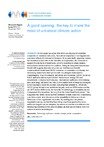In this paper we argue that when a subgroup of countries cooperate on emission reduction, the optimal response of non-signatories countries reflects the interaction between three potentially opposing factors, the incentive to free-ride on the benefits of cooperation, the incentive to expand the demand of fossil fuels, and the incentive to adopt cleaner technologies introduced by the coalition. Using an Integrated Assessment Model with a game theoretic structure we find that cost-benefit considerations would lead OECD countries to under take a moderate, but increasing abatement effor t (in line with the pledges subscribed in Copenhagen). Even if emission reductions are moderate, OECD countries find it optimal to allocate par t of their resources to energy RD and investments in cleaner technologies. International spillovers of knowledge and technology diffusion then lead to the deployment of these technologies in non-signator y countries as well, reducing their emissions. When the OECD group follows more ambitious targets, such as 2050 emissions that are 50% below 2005 levels, the benefits of technology externalities do not compensate the incentives deriving from the lower fossil fuels prices. This suggests that, when choosing their unilateral climate objective, cooperating countries should take into account the possibility to induce a vir tuous behaviour in non-signatories countries. By looking at a two-phase negotiation set-up, we find that free riding incentives spurred by more ambitious targets can be mitigated by means of credible commitments for developing countries in the second phase, as they would reduce lock-in in carbon intensive technologies.
- issn: Q54, Q55, C72
CMCC Divisions
Authors
- Keywords: climate change, partial cooperation, technology spillovers


